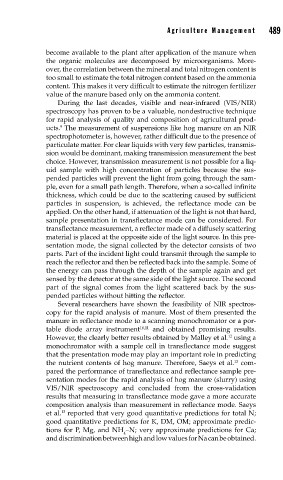Page 517 - Biosystems Engineering
P. 517
Agricultur e Management 489
become available to the plant after application of the manure when
the organic molecules are decomposed by microorganisms. More-
over, the correlation between the mineral and total nitrogen content is
too small to estimate the total nitrogen content based on the ammonia
content. This makes it very difficult to estimate the nitrogen fertilizer
value of the manure based only on the ammonia content.
During the last decades, visible and near-infrared (VIS/NIR)
spectroscopy has proven to be a valuable, nondestructive technique
for rapid analysis of quality and composition of agricultural prod-
9
ucts. The measurement of suspensions like hog manure on an NIR
spectrophotometer is, however, rather difficult due to the presence of
particulate matter. For clear liquids with very few particles, transmis-
sion would be dominant, making transmission measurement the best
choice. However, transmission measurement is not possible for a liq-
uid sample with high concentration of particles because the sus-
pended particles will prevent the light from going through the sam-
ple, even for a small path length. Therefore, when a so-called infinite
thickness, which could be due to the scattering caused by sufficient
particles in suspension, is achieved, the reflectance mode can be
applied. On the other hand, if attenuation of the light is not that hard,
sample presentation in transflectance mode can be considered. For
transflectance measurement, a reflector made of a diffusely scattering
material is placed at the opposite side of the light source. In this pre-
sentation mode, the signal collected by the detector consists of two
parts. Part of the incident light could transmit through the sample to
reach the reflector and then be reflected back into the sample. Some of
the energy can pass through the depth of the sample again and get
sensed by the detector at the same side of the light source. The second
part of the signal comes from the light scattered back by the sus-
pended particles without hitting the reflector.
Several researchers have shown the feasibility of NIR spectros-
copy for the rapid analysis of manure. Most of them presented the
manure in reflectance mode to a scanning monochromator or a por-
table diode array instrument 10,11 and obtained promising results.
However, the clearly better results obtained by Malley et al. using a
12
monochromator with a sample cell in transflectance mode suggest
that the presentation mode may play an important role in predicting
13
the nutrient contents of hog manure. Therefore, Saeys et al. com-
pared the performance of transflectance and reflectance sample pre-
sentation modes for the rapid analysis of hog manure (slurry) using
VIS/NIR spectroscopy and concluded from the cross-validation
results that measuring in transflectance mode gave a more accurate
composition analysis than measurement in reflectance mode. Saeys
et al. reported that very good quantitative predictions for total N;
13
good quantitative predictions for K, DM, OM; approximate predic-
tions for P, Mg, and NH –N; very approximate predictions for Ca;
4
and discrimination between high and low values for Na can be obtained.

